Agricultural Production Can Be a Carbon Sink: A Case Study of Jinchang City
Abstract
:1. Introduction
2. Materials and Methods
2.1. Study Area
2.2. Data and Methods
2.2.1. Agricultural Carbon Emission Calculation
= [(AN × FN + AP × FP + AK × FK + Acf × Fcf) + (Apf × Fpf)] × 0.001 + [(Si × Fi) + Ssa × (Fplow + Fplant + Fharvest) + (Wm × Fm)] × 0.001
2.2.2. Calculation of Carbon Sequestration
2.2.3. Calculation of Other Carbon Indicators
3. Results and Discussion
3.1. Analysis of Agricultural Production Conditions
3.2. Variation in Carbon Emissions in Agricultural Production
3.3. Calculation of Carbon Sequestration
3.3.1. Changes in Total Carbon Sequestration and Its Intensity
3.3.2. Variation of Carbon Sequestration and Its Intensity in Different Crops
3.4. Analysis of Carbon Indicators
4. Conclusions
Author Contributions
Funding
Data Availability Statement
Conflicts of Interest
References
- Matuštík, J.; Kočí, V. What is a footprint? A conceptual analysis of environmental footprint indicators. J. Clean. Prod. 2021, 285, 124833. [Google Scholar] [CrossRef]
- Zhang, X.; Shi, X.; Khan, Y.; Hassan, T.; Marie, M. Carbon Neutrality Challenge: Analyse the Role of Energy Productivity, Renewable Energy, and Collaboration in Climate Mitigation Technology in OECD Economies. Sustainability 2023, 15, 3447. [Google Scholar] [CrossRef]
- Khan, Y.; Oubaih, H.; Elgourrami, F.Z. The effect of renewable energy sources on carbon dioxide emissions: Evaluating the role of governance, and ICT in Morocco. Renew. Energy 2022, 190, 752–763. [Google Scholar] [CrossRef]
- Nayak, N.; Mehrotra, R.; Mehrotra, S. Carbon biosequestration strategies: A review. Carbon Capture Sci. Technol. 2022, 4, 100065. [Google Scholar] [CrossRef]
- Zeebe, R.E.; Ridgwell, A.; Zachos, J.C. Anthropogenic carbon release rate unprecedented during the past 66 million years. Nat. Geosci. 2016, 9, 325–329. [Google Scholar] [CrossRef]
- Hu, Y.B.; Zhang, Q.; Hu, S.J.; Xiao, G.J.; Chen, X.Y.; Wang, J.S.; Qi, Y.; Zhang, L.; Han, L.Y. Research progress and prospects of ecosystem carbon sequestration under climate change (1992–2022). Ecol. Indic. 2022, 145, 109656. [Google Scholar] [CrossRef]
- Chataut, G.; Bhatta, B.; Joshi, D.; Subedi, K.; Kafle, K. Greenhouse gases emission from agricultural soil: A review. J. Agric. Food. Res. 2023, 11, 100533. [Google Scholar] [CrossRef]
- Verge, X.P.C.; De, K.C.; Desjardins, R.L. Agricultural production, greenhouse gas emissions and mitigation potential. Agric. Meteorol. 2007, 142, 255–269. [Google Scholar] [CrossRef]
- Yang, H.W.; Hu, F.L.; Yin, W.; Chai, Q.; Zhao, C.; Yu, A.Z.; Fan, Z.L.; Fan, H.; Ren, X.L. Integration of tillage and planting density improves crop production and carbon mitigation of maize/pea intercropping in the oasis irrigation area of northwestern China. Field Crops Res. 2021, 272, 108281. [Google Scholar] [CrossRef]
- The World Bank. CO2 Emissions (Kt). Washington, DC, USA. 2019. Available online: https://data.worldbank.org/indicator/EN.ATM.CO2E.KT?amp%3Bmost_recent_value_desc=true&%3Bstart=1990&end=2019&start=1990 (accessed on 16 September 2022).
- Liu, M.C.; Yang, L. Spatial pattern of China’s agricultural carbon emission performance. Ecol. Indic. 2021, 133, 108345. [Google Scholar] [CrossRef]
- Chen, M.P.; Cui, Y.R.; Jiang, S.; Forsell, N. Toward carbon neutrality before 2060: Trajectory and technical mitigation potential of non-CO2 greenhouse gas emissions from Chinese agriculture. J. Clean. Prod. 2022, 368, 133186. [Google Scholar] [CrossRef]
- Li, M.; Peng, J.Y.; Lu, Z.X.; Zhu, P.Y. Research progress on carbon sources and sinks of farmland ecosystems. Res. Environ. Sustain. 2022, 11, 100099. [Google Scholar] [CrossRef]
- IPCC (Intergovernmental Panel on Climate Change). Climate Change 2022: Mitigation of Climate Change; Shukla, P.R., Skea, J., Slade, R., Al Khourdajie, A., van Diemen, R., McCollum, D., Pathak, M., Some, S., Vyas, P., Fradera, R., et al., Eds.; Cambridge University Press: Cambridge, UK; New York, NY, USA, 2022; Available online: https://www.ipcc.ch/report/ar6/wg3/downloads/report/IPCC_AR6_WGIII_SummaryForPolicymakers.pdf (accessed on 25 November 2022).
- Maier, R.; Hörtnag, L.; Buchmann, N. Greenhouse gas fluxes (CO2, N2O and CH4) of pea and maize during two cropping seasons: Drivers, budgets, and emission factors for nitrous oxide. Sci. Total Environ. 2022, 849, 157541. [Google Scholar] [CrossRef]
- Congressional Research Service (CRS). Greenhouse Gas Emissions and Sinks in U.S. Agriculture. 2022. Available online: https://sgp.fas.org/crs/misc/IF11404.pdf (accessed on 22 November 2022).
- IPCC. Climate Change 2014: Impacts, Adaptation, and Vulnerability. Part A: Global and Sectoral Aspects Contribution of Working Group II to the Fifth Assessment Report of the Intergovernmental Panel on Climate Change; Cambridge University Press: Cambridge, UK; New York, NY, USA, 2014. [Google Scholar]
- Snyder, C.S.; Bruulsema, T.W.; Jensen, T.L.; Fixen, P.E. Review of greenhouse gas emissions from crop production systems and fertilizer management effects. Agric. Ecol. Environ. 2009, 133, 247–266. [Google Scholar] [CrossRef]
- Huang, X.; Xu, X.; Wang, Q.; Zhang, L.; Gao, X.; Chen, L. Assessment of agricultural carbon emissions and their spatiotemporal changes in China, 1997–2016. Int. J. Environ. Res. Public Health 2019, 16, 3105. [Google Scholar] [CrossRef]
- Hu, Y.C.; Su, M.R.; Jiao, L.M. Peak and fall of China’s agricultural GHG emissions. J. Clean. Prod. 2023, 389, 136035. [Google Scholar] [CrossRef]
- Guan, X.; Zhang, J.; Wu, X.; Cheng, L. The shadow prices of carbon emissions in China’s planting industry. Sustainability 2018, 10, 753. [Google Scholar] [CrossRef]
- Lv, Y.; Liu, J.; Cheng, J.; Andreoni, V. The persistent and transient total factor carbon emission performance and its economic determinants: Evidence from China’s province-level panel data. J. Clean. Prod. 2021, 316, 128198. [Google Scholar] [CrossRef]
- Gangopadhyay, S.; Banerjee, R.; Batabyal, S.; Das, N.; Mondal, A.; Pal Chandra, S.; Mandal, S. Carbon sequestration and greenhouse gas emissions for different rice cultivation practices. Sustain. Prod. Consum. 2022, 34, 90–104. [Google Scholar] [CrossRef]
- Wang, Y.C.; Tao, F.L.; Yin, L.C.; Chen, Y. Spatiotemporal changes in greenhouse gas emissions and soil organic carbon sequestration for major cropping systems across China and their drivers over the past two decades. Sci. Total Environ. 2022, 833, 155087. [Google Scholar] [CrossRef]
- Kuyah, S.; Muoni, T.; Bayala, J.; Chopin, P.; Dahlin, A.S.; Hughes, K.; Jonsson, M.; Kumar, S.; Sileshi, G.W.; Dimobe, K.; et al. Grain legumes and dryland cereals contribute to carbon sequestration in the drylands of Africa and South Asia. Agric. Ecol. Environ. 2023, 355, 108583. [Google Scholar] [CrossRef]
- Tian, P.P.; Li, D.; Lu, H.W.; Feng, S.S.; Nie, Q.W. Trends, distribution, and impact factors of carbon footprints of main grains production in China. J. Clean. Prod. 2021, 278, 123347. [Google Scholar] [CrossRef]
- Statistics Department of Jinchang. Jinchang Statistical Yearbook (Chinese Edition). Jinchang. 2020. Available online: http://tjj.jcs.gov.cn/zfxxgk/fdzdgknr/tjxx/tjnj/art/2022/art_bbade7946cba4ca5b8e8da1c6f8e59a2.html (accessed on 26 July 2022).
- Statistics Department of Jinchang. Jinchang Statistical Yearbook (Chinese Edition). Jinchang. 2018–2019. Available online: http://tjj.jcs.gov.cn/zfxxgk/fdzdgknr/tjxx/tjnj/ (accessed on 26 July 2022).
- Li, M.Q.; Liu, S.L.; Sun, Y.X.; Liu, Y.X. Agriculture and animal husbandry increased carbon footprint on the Qinghai-Tibet Plateau during past three decades. J. Clean. Prod. 2021, 278, 123963. [Google Scholar] [CrossRef]
- Bao, Q.J.; Pan, Y.D.; Zhang, H.Y.; Liu, X.N.; Zhang, D.J.; Zhao, F. Effect of reducing fertilizer application on dry matter accumulation, yield and fertilizer utilization efficiency of beer barely. J. Agric. Sci. Technol. 2020, 22, 149–158. [Google Scholar]
- Lal, R. Carbon emission from farm operations. Environ. Int. 2004, 30, 981–990. [Google Scholar] [CrossRef] [PubMed]
- Chen, R.; Zhang, R.Y.; Han, H.Y.; Jiang, Z.D. Is farmers’ agricultural production a carbon sink or source?—Variable system boundary and household survey data. J. Clean. Prod. 2020, 266, 122108. [Google Scholar] [CrossRef]
- United Nations. Global Issues Population. Peace, Dignity and Equality on a Healthy Planet. Available online: https://www.un.org/zh/global-issues/population (accessed on 2 August 2023).
- Walling, E.; Vaneeckhaute, C. Greenhouse gas emissions from inorganic and organic fertilizer production and use: A review of emission factors and their variability. J. Environ. Manag. 2020, 276, 111211. [Google Scholar] [CrossRef]
- The Food and Agriculture Organization of the United Nation (FAO). Inorganic Fertilizers 2000–2021. In FAOSTAT Analytical Brief 68; FAO: Rome, Italy, 2021; Available online: https://www.fao.org/3/cc6823en/cc6823en.pdf (accessed on 2 August 2023).
- Menegat, S.; Ledo, A.; Tirado, R. Greenhouse gas emissions from global production and use of nitrogen synthetic fertilizers in agriculture. Sci. Rep. 2022, 12, 14490. [Google Scholar] [CrossRef] [PubMed]
- Guo, C.; Liu, X.F.; He, X.F. A global meta-analysis of crop yield and agricultural greenhouse gas emissions under nitrogen fertilizer application. Sci. Total Environ. 2022, 831, 154982. [Google Scholar] [CrossRef]
- Rural Socio Economic Survey Department of the National Bureau of Statistics. China Rural Statistical Yearbook; China Statistical Press: Beijing, China, 2022. [Google Scholar]
- Gao, H.H.; Liu, Q.; Yan, C.R.; Wu, Q.; Gong, D.Z.; He, W.Q.; Liu, H.J.; Wang, J.L.; Mei, X.R. Mitigation of greenhouse gas emissions and improved yield by plastic mulching in rice production. Sci. Total Environ. 2023, 880, 162984. [Google Scholar] [CrossRef]
- Yu, Y.X.; Zhang, Y.X.; Xiao, M.; Zhao, C.Y.; Yao, H.Y. A meta-analysis of film mulching cultivation effects on soil organic carbon and soil greenhouse gas fluxes. CATENA 2021, 206, 105483. [Google Scholar] [CrossRef]
- Tan, T.L.; Zulkifli, N.A.; Zaman, A.S.K.; Jusoh, M.B.; Yaapar, M.N.; Rashid, S.A. Impact of photoluminescent carbon quantum dots on photosynthesis efficiency of rice and corn crops. Plant Physiol. Biochem. 2021, 162, 737–751. [Google Scholar] [CrossRef]
- Li, F. Jinchang City Continuously Improve the Efficiency of Comprehensive Utilization of Agricultural Resources. Jinchang Daily, 13 October 2020. Available online: https://wap.cnki.net/touch/web//Newspaper/list/JCBR20201013(accessed on 16 August 2022).
- Zhang, K.L. Jinchang City Continuously Improve the Quality of Cultivated Land in Order to Ensure Food Security. 4 March 2022. Available online: http://gs.people.com.cn/n2/2022/0304/c397687-35159535.html (accessed on 16 August 2022).
- Dong, H.T.; Yang, G.; Zhang, Y.M.; Yang, Y.Y.; Wang, D.W.; Zhou, C.B. Recycling, disposal, or biodegradable-alternative of polyethylene plastic film for agricultural mulching? A life cycle analysis of their environmental impacts. J. Clean. Prod. 2022, 380, 134950. [Google Scholar] [CrossRef]
- Ming, G.H.; Hu, H.C.; Tian, F.Q.; Khan, A.M.Y.; Zhang, Q. Carbon budget for a plastic-film mulched and drip-irrigated cotton field in an oasis of Northwest China. Agric. For. Meteorol. 2021, 306, 108447. [Google Scholar] [CrossRef]
- Zhao, C.; Chai, Q.; Cao, W.D.; Whalen, J.K.; Zhao, L.X.; Cai, L.J. No-tillage reduces competition and enhances compensatory growth of maize (Zea mays L.) intercropped with pea (Pisum sativum L.). Field Crops Res. 2019, 243, 107611. [Google Scholar] [CrossRef]
- Liu, D.T.; Song, C.C.; Xin, Z.H.; Fang, C.; Liu, Z.H.; Xu, Y.P. Agricultural management strategies for balancing yield increase, carbon sequestration, and emission reduction after straw return for three major grain crops in China: A meta-analysis. J. Environ. Manag. 2023, 340, 117965. [Google Scholar] [CrossRef] [PubMed]
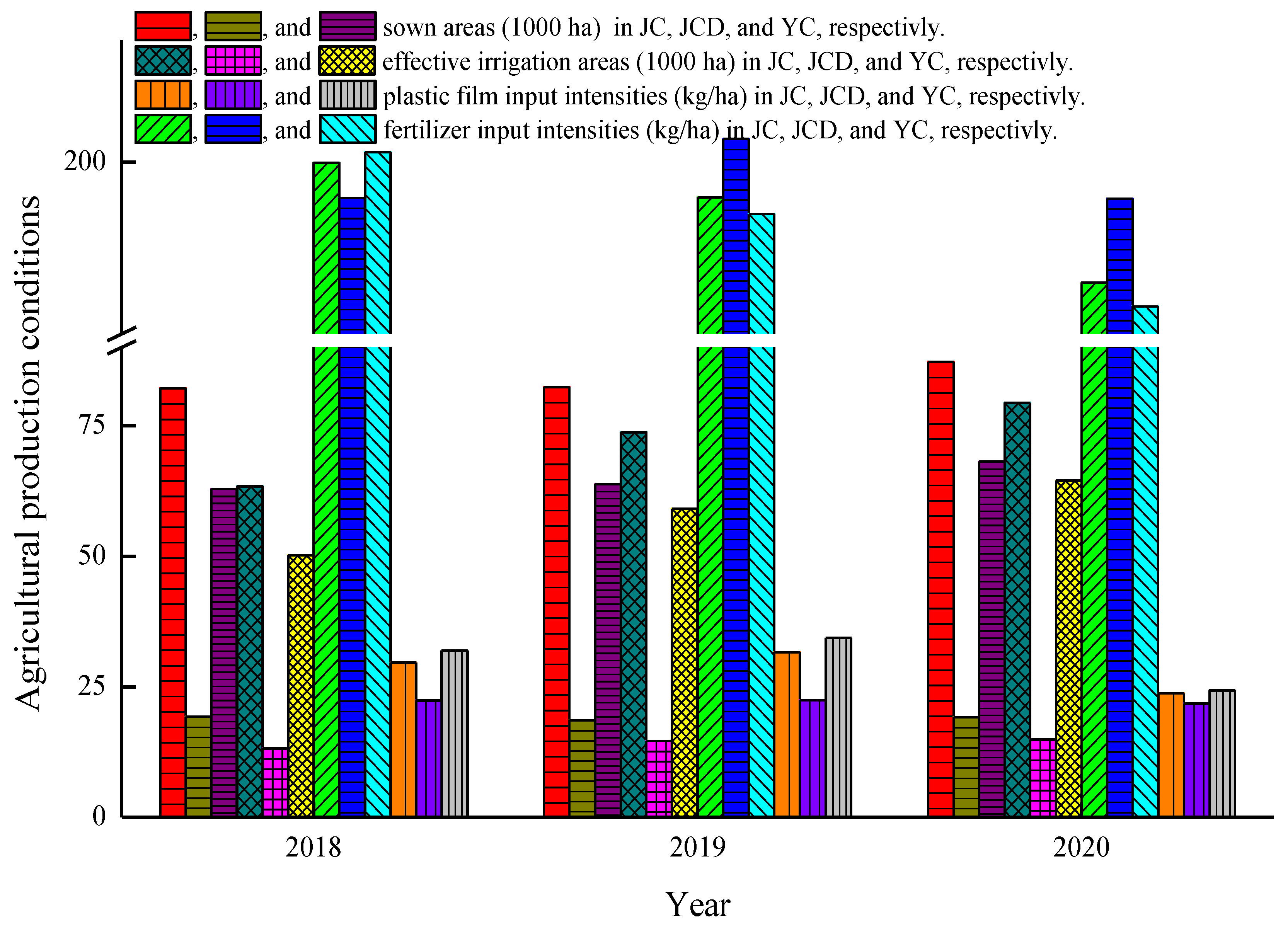
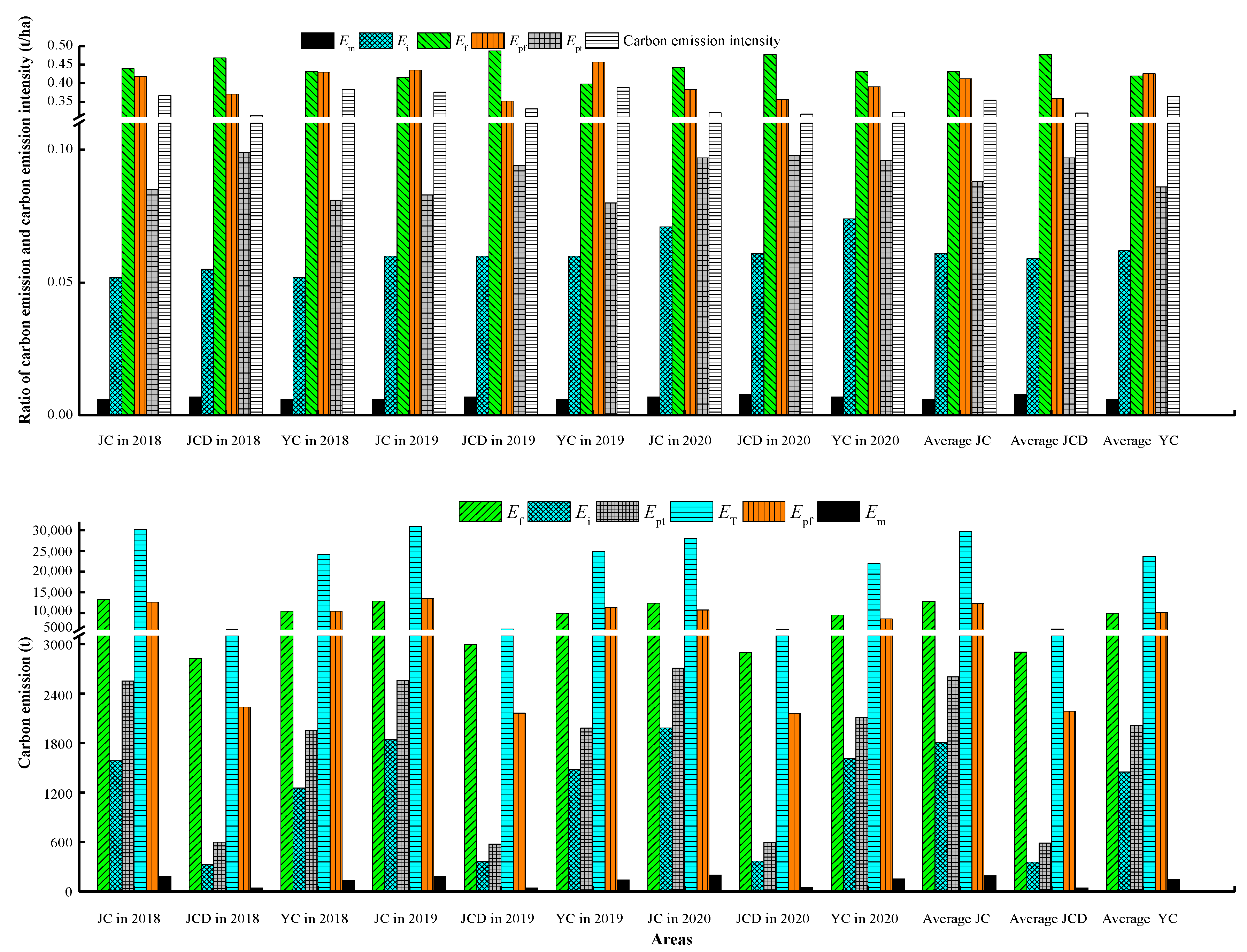
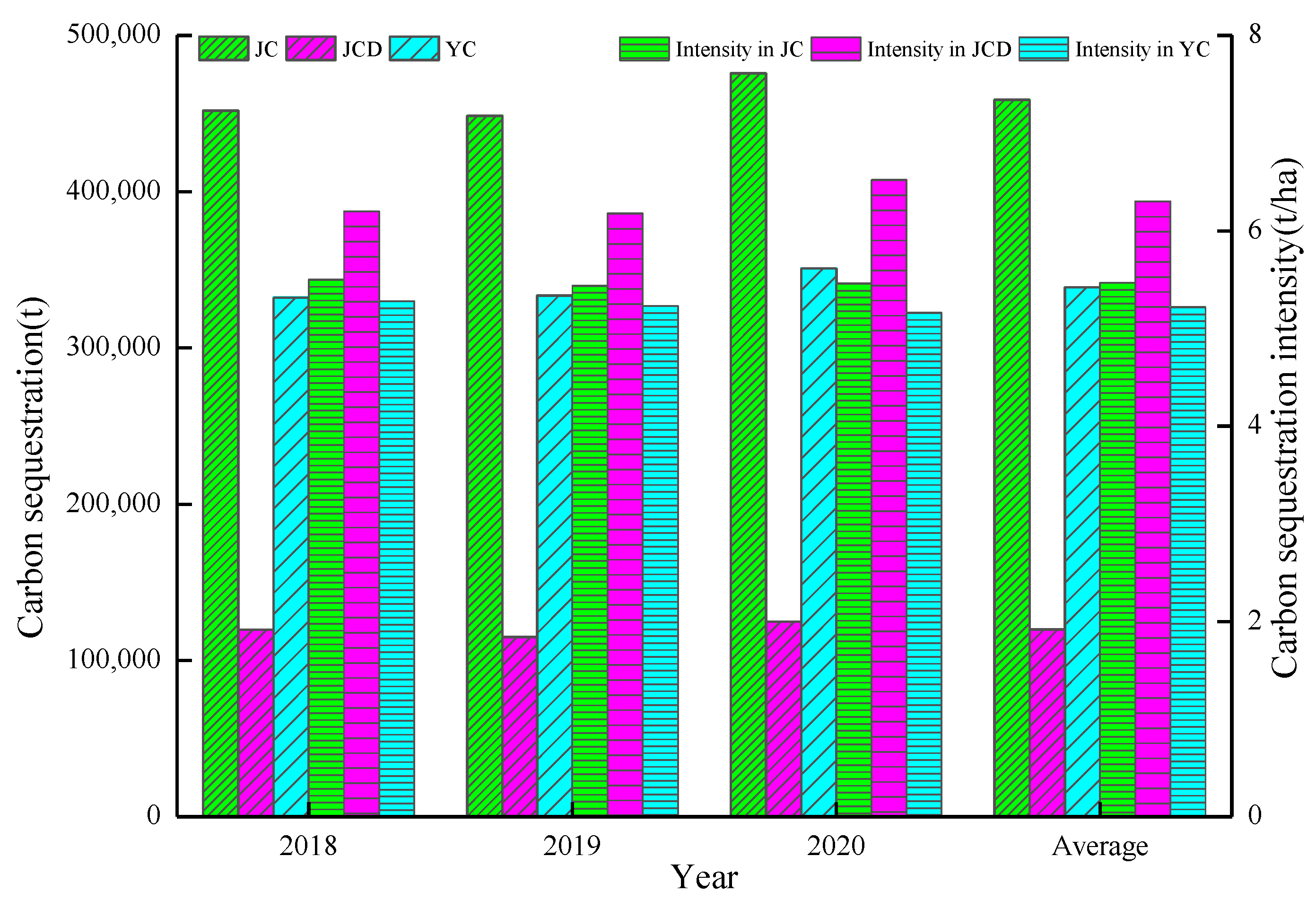
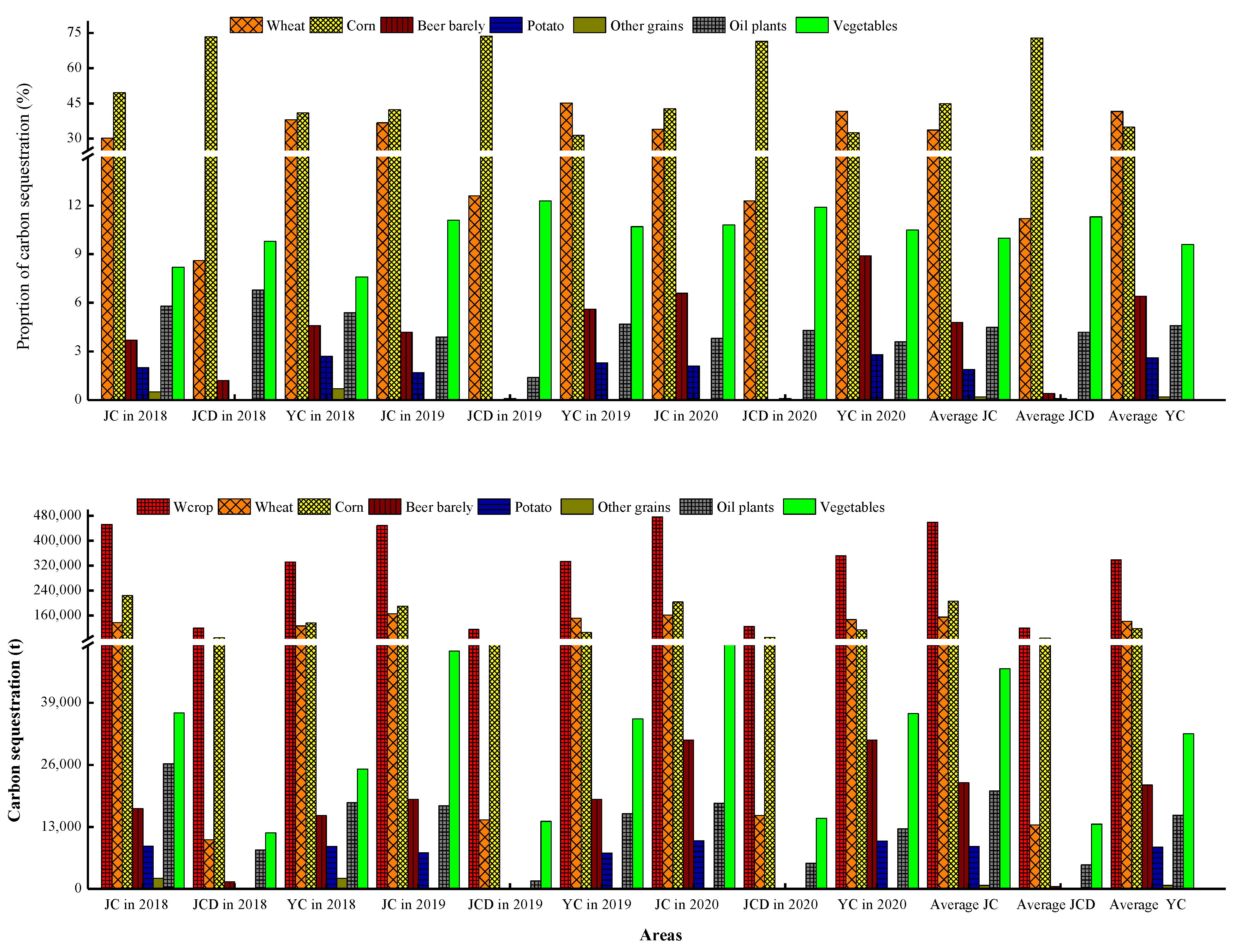
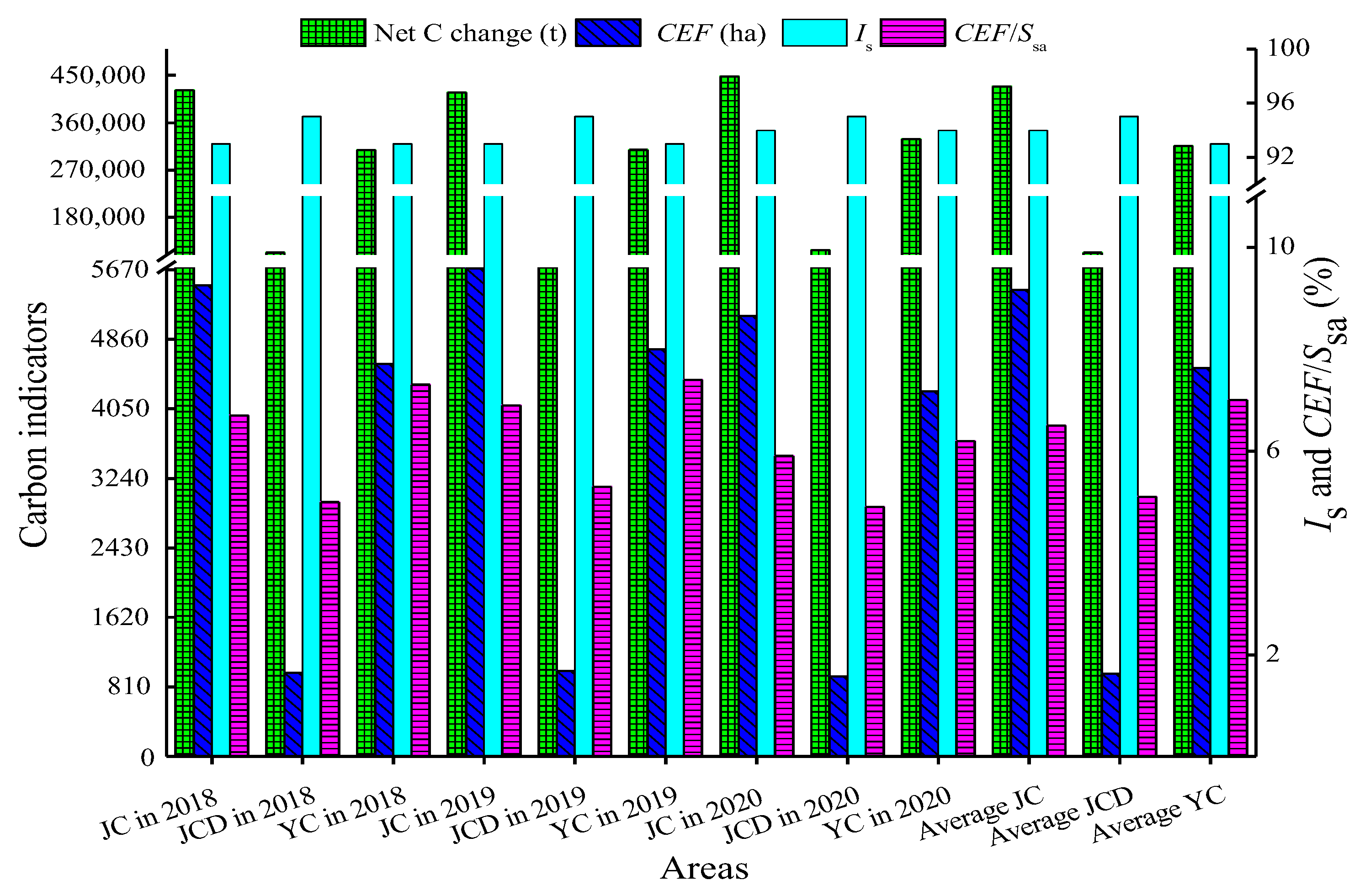
| Crop Types | Carbon Conversion Coefficient (Ci) | Rate of Water Content (Vi) | Economic Coefficient (Hi) |
|---|---|---|---|
| Wheat | 0.485 | 0.12 | 0.40 |
| Beer barley | 0.450 | 0.12 | 0.51 |
| Corn | 0.471 | 0.13 | 0.40 |
| Other grains | 0.450 | 0.15 | 0.40 |
| Potato | 0.423 | 0.70 | 0.70 |
| Oil plants | 0.450 | 0.09 | 0.25 |
| Vegetables | 0.450 | 0.90 | 0.65 |
Disclaimer/Publisher’s Note: The statements, opinions and data contained in all publications are solely those of the individual author(s) and contributor(s) and not of MDPI and/or the editor(s). MDPI and/or the editor(s) disclaim responsibility for any injury to people or property resulting from any ideas, methods, instructions or products referred to in the content. |
© 2023 by the authors. Licensee MDPI, Basel, Switzerland. This article is an open access article distributed under the terms and conditions of the Creative Commons Attribution (CC BY) license (https://creativecommons.org/licenses/by/4.0/).
Share and Cite
Chang, G.; Liu, H.; Yin, Z.; Wang, J.; Li, K.; Gao, T. Agricultural Production Can Be a Carbon Sink: A Case Study of Jinchang City. Sustainability 2023, 15, 12872. https://doi.org/10.3390/su151712872
Chang G, Liu H, Yin Z, Wang J, Li K, Gao T. Agricultural Production Can Be a Carbon Sink: A Case Study of Jinchang City. Sustainability. 2023; 15(17):12872. https://doi.org/10.3390/su151712872
Chicago/Turabian StyleChang, Guohua, Hao Liu, Zhuoxin Yin, Jinxiang Wang, Kaiming Li, and Tianpeng Gao. 2023. "Agricultural Production Can Be a Carbon Sink: A Case Study of Jinchang City" Sustainability 15, no. 17: 12872. https://doi.org/10.3390/su151712872







